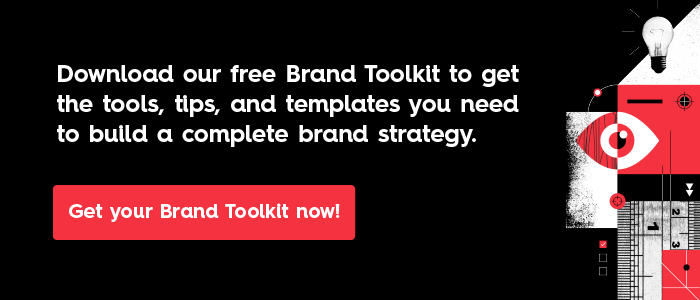A branding strategy is, in essence, the blueprint for how you want to build, shape, and share your brand. Whether you’re a tiny startup or a legacy brand that’s been around a hundred years, a strong brand strategy is the only way to ensure health and growth. But many brands have a strategy that’s incomplete or ineffective—if they have one at all.
Why is this a problem? Without a documented brand strategy (and, therefore, a cohesive vision), you can end up with a misaligned organization and a chaotic marketing department plagued by:
- Siloed communication
- Ineffective marketing
- Messaging inconsistency
- Execution challenges
- Inefficient use of resources
If any of these symptoms sound familiar, here’s why you need to realign your brand ASAP.

7 Ways You Can Succeed with a Brand Strategy
If you want to build a healthy company, cultivate a strong culture, and make the people who buy your product or service more loyal to your brand, you need a well-articulated strategy. Here are seven ways a brand strategy helps you navigate the most common roadblocks to building a brand—and benefits both your business and the people you work for and with.
1) Define your purpose.
People don’t just care about product features. They care about aligning themselves with a brand that reflects their values and has a clear purpose.
PRODUCT FEATURES → BRAND VALUES
In the wake of the 2020’s Pandemic and social unrest, Vrity research found that…
- 55% of consumers said they pay more attention to brand values than they did pre-pandemic.
- 52% said they have bought from a brand for the first time because of its values.
- 82% said they would pick one brand over another—and pay more—because of their brand values.
A brand strategy helps you articulate your core identity (aka your purpose, vision, mission, and values) and, most importantly, communicate it. Ultimately, understanding your brand’s beliefs, building an organization that reflects them, and telling your brand story effectively is crucial to attract and retain the people you want to reach.
If you want to find and share your purpose more effectively…
- Clarify your own purpose, vision, mission, and values. See our guide to find your brand heart.
- Start within your own four walls. Find out how to build a stronger employer brand based on those values.
- Tell stories about your values. Try these tips to create culture marketing that shows people who you are and what you care about, and get inspired by how these brands share their values through content.
2) Build trust with your audience.
A brand isn’t a tangible thing. It is a composite of many things, but above all it is crafted by people’s perceptions of you—specifically, their feelings about you.
To cultivate that trust, you must be transparent, honest, and authentic. Having clearly identified values also helps here, but a brand strategy helps you take a comprehensive look at your entire brand ecosystem and identify opportunities to improve the customer experience and strengthen your relationship.
As Marty Neumeier says in The Brand Gap, “Customers trust your brand when their experiences consistently meet or beat their expectations.”
If you want to build trust with your audience…
- Create data storytelling. Hard numbers and credible data are a great way to position your brand as an authority. Learn more about how to find interesting data stories.
- Get the BS out of your content. Find out how to make truly valuable content that enhances people’s lives.
3) Differentiate your brand.
Why should people choose your brand over others? What makes you different? If you don’t have a clear differentiation, they won’t. A brand strategy is key to help you articulate this.
As Neumeier notes, you must be able to succinctly answer these three questions to build a brand:
- Who are you?
- What do you do?
- Why does it matter?
Don’t have these answers? Then your brand strategy will fail.
If you want to differentiate your brand…
- Know who your competition is. Follow our guide to conduct a full competitive analysis.
- Create a strong visual identity. Download our brand identity toolkit and find out how to design an identity that tells your brand story.
- Look for gaps in your content. Do a competitor content audit to find out how they’re telling their brand story—and how you can tell yours better.
4) Improve team collaboration.
A strong brand strategy helps keep everyone on the same page, letting you get a better view of the big picture and work toward a common goal. Again, who are you? What are you trying to achieve? How are you trying to achieve it?
When your team is aligned, you can better assign roles, allocate resources, and communicate more effectively, whether you’re working on a new product or coming up with a new marketing campaign. This also helps save valuable resources, including time, money, and energy.
For more tips on collaboration…
- Understand your team better. Learn how to identify and work with the 4 types of creative thinkers. This will help you understand why people on your team think the way they do and learn how to channel their strengths to make your ideas better.
- Set yourself up for success. Try these tips to hold better brainstorms.
- Improve the way you work with outsiders. Find out how to cultivate a better relationship with your content agency if you outsource any of your work.
5) Cultivate a better company culture.
According to Energage, more than 75 percent of job seekers consider an employer’s brand before they submit a resume. This means it’s not just customers who care about how you act. In fact, it’s your employees who want you to talk the talk and walk the walk most—and not just in marketing materials.
Just like building a relationship with a consumer, to attract and retain the best employees, you need to foster a culture where everyone is bonded and driven by the same values. In a healthy company, those values influence everything from how you conduct annual reviews to how you reward great work. If you know what you’re working towards—and why—it is easier to cultivate a happier, healthier work environment. Note: According to McKinsey research, 70% of employees said that their sense of purpose is defined by their work. Translation: The more purpose-driven that work is, the more retention you’ll have.
For more tips on cultivating a better culture…
- Focus on your employer brand. When you create the right culture, you attract the right employees. To start, see our guide to create a strong company culture.
- Make the most of tech and tools. From games to ice breakers, here are 50 tools to build a better culture.
- Include your remote members. If you don’t have a team that regularly comes to the office, cultivating your culture can be a bit more challenging. Try these tips to keep a remote workforce bonded.
6) Foster innovation.
Innovation is crucial to survival, yet it can be a scary prospect. To lead with confidence, you have to push and challenge your team. With a strong culture and committed vision, you can create space for innovation that supports your brand goals.
It’s worthwhile to note that a brand strategy also gives you constraints, which are equally helpful for breeding innovation. Your brand strategy is just as much about choosing what you aren’t as what you are. (Think of Google’s “don’t be evil” policy.) This can provide much-needed guidelines for decision-making.
For more tips on fostering innovation…
- Stop focusing on growth hacking. Focus on brand building instead.
- Embrace moonshot thinking. Find out how we revamped our content marketing with a moonshot strategy.
7) Ensure growth.
Once you’ve built your brand, the instinct is to preserve it. While this makes sense, your ultimate goal should be to grow your brand—intentionally and with purpose. This means doing whatever you need to fulfill your brand promise.
As Denise Lee Yohn notes in What Great Brands Do, “Your brand can’t just be a promise; it must be a promise delivered.”
Delivering that promise to your customers (and stakeholders) takes a village. You need the right focus, the right brand stewards, and the right intentions. A brand strategy serves as a compass to ensure you do this successfully. As Neumeier says, “No decision should be made without asking, ‘Will it help or hurt the brand?’”
A strategy is your best defense against stagnation.
For more tips on growing your brand…
- Build the right team. Find out how the right team can help you succeed.
- Understand what works and what doesn’t. Find out how to measure the success of your marketing campaigns.
- Put strategy first. Once you have your brand strategy established, work on creating a content strategy that will set you up for success.
How Do You Create a Branding Strategy?
Building a strong brand strategy is a challenging but exciting process. If you need to build one from scratch or make sure yours is fully fleshed out, follow our step-by-step guide to create a brand strategy, and download our free brand strategy toolkit.
But if you don’t have time or are already overwhelmed, hit us up and we can help you out.






It’s nice that you talked about how a brand strategy could help you articulate your core identity and, most importantly, communicate it. I was listening to an audiobook about businesses yesterday and I heard a bit about the value of branding. It looks like there are brand development services now too, which seems very useful for businesses.
https://hookworldwide.com/our-work/#branding-2